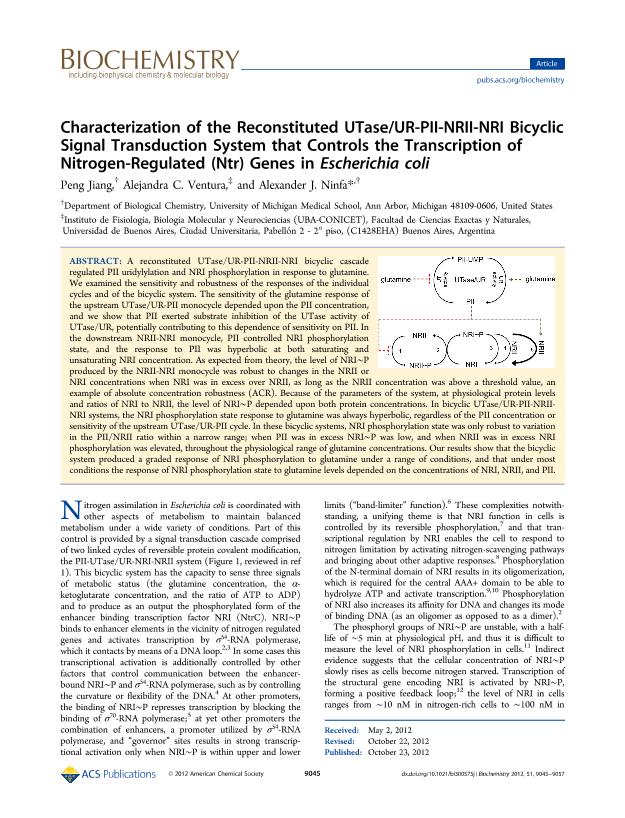Mostrar el registro sencillo del ítem
dc.contributor.author
Jiang, Peng
dc.contributor.author
Ventura, Alejandra

dc.contributor.author
Ninfa, Alexander J.
dc.date.available
2017-07-12T16:51:47Z
dc.date.issued
2012-10
dc.identifier.citation
Jiang, Peng; Ventura, Alejandra; Ninfa, Alexander J.; Characterization of the Reconstituted UTase/UR-PII-NRII-NRI Bicyclic Signal Transduction System that Controls the Transcription of Nitrogen-Regulated (Ntr) Genes in Escherichia coli; American Chemical Society; Biochemistry; 51; 45; 10-2012; 9045-9057
dc.identifier.issn
0006-2960
dc.identifier.uri
http://hdl.handle.net/11336/20230
dc.description.abstract
A reconstituted UTase/UR-PII-NRII-NRI bicyclic cascade regulated PII uridylylation and NRI phosphorylation in response to glutamine. We examined the sensitivity and robustness of the responses of the individual cycles and of the bicyclic system. The sensitivity of the glutamine response of the upstream UTase/UR-PII monocycle depended upon the PII concentration, and we show that PII exerted substrate inhibition of the UTase activity of UTase/UR, potentially contributing to this dependence of sensitivity on PII. In the downstream NRII-NRI monocycle, PII controlled NRI phosphorylation state, and the response to PII was hyperbolic at both saturating and unsaturating NRI concentration. As expected from theory, the level of NRI∼P produced by the NRII-NRI monocycle was robust to changes in the NRII or NRI concentrations when NRI was in excess over NRII, as long as the NRII concentration was above a threshold value, an example of absolute concentration robustness (ACR). Because of the parameters of the system, at physiological protein levels and ratios of NRI to NRII, the level of NRI∼P depended upon both protein concentrations. In bicyclic UTase/UR-PII-NRIINRI systems, the NRI phosphorylation state response to glutamine was always hyperbolic, regardless of the PII concentration or sensitivity of the upstream UTase/UR-PII cycle. In these bicyclic systems, NRI phosphorylation state was only robust to variation in the PII/NRII ratio within a narrow range; when PII was in excess NRI∼P was low, and when NRII was in excess NRI phosphorylation was elevated, throughout the physiological range of glutamine concentrations. Our results show that the bicyclic system produced a graded response of NRI phosphorylation to glutamine under a range of conditions, and that under most conditions the response of NRI phosphorylation state to glutamine levels depended on the concentrations of NRI, NRII, and PII.
dc.format
application/pdf
dc.language.iso
eng
dc.publisher
American Chemical Society

dc.rights
info:eu-repo/semantics/openAccess
dc.rights.uri
https://creativecommons.org/licenses/by-nc-sa/2.5/ar/
dc.subject
Signal Transduction
dc.subject
E Coli
dc.subject
Sensitivity
dc.subject.classification
Biofísica

dc.subject.classification
Ciencias Biológicas

dc.subject.classification
CIENCIAS NATURALES Y EXACTAS

dc.title
Characterization of the Reconstituted UTase/UR-PII-NRII-NRI Bicyclic Signal Transduction System that Controls the Transcription of Nitrogen-Regulated (Ntr) Genes in Escherichia coli
dc.type
info:eu-repo/semantics/article
dc.type
info:ar-repo/semantics/artículo
dc.type
info:eu-repo/semantics/publishedVersion
dc.date.updated
2017-07-12T14:51:15Z
dc.journal.volume
51
dc.journal.number
45
dc.journal.pagination
9045-9057
dc.journal.pais
Estados Unidos

dc.journal.ciudad
Washington DC
dc.description.fil
Fil: Jiang, Peng. University of Michigan; Estados Unidos
dc.description.fil
Fil: Ventura, Alejandra. Consejo Nacional de Investigaciones Científicas y Técnicas. Oficina de Coordinación Administrativa Ciudad Universitaria. Instituto de Fisiología, Biología Molecular y Neurociencias. Universidad de Buenos Aires. Facultad de Ciencias Exactas y Naturales. Instituto de Fisiología, Biología Molecular y Neurociencias; Argentina
dc.description.fil
Fil: Ninfa, Alexander J.. University of Michigan; Estados Unidos
dc.journal.title
Biochemistry

dc.relation.alternativeid
info:eu-repo/semantics/altIdentifier/doi/http://dx.doi.org/10.1021/bi300575j
dc.relation.alternativeid
info:eu-repo/semantics/altIdentifier/url/http://pubs.acs.org/doi/abs/10.1021/bi300575j
Archivos asociados
